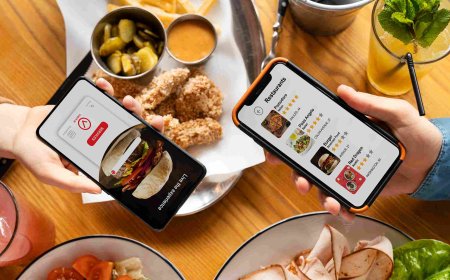How to Find Authentic Ramen in Phoenix
How to Find Authentic Ramen in Phoenix Phoenix, Arizona—known for its desert heat, sprawling suburbs, and vibrant culinary scene—is not the first place that comes to mind when you think of authentic Japanese ramen. Yet, over the past decade, the city has quietly evolved into a surprising hub for high-quality, traditionally crafted ramen. From rich tonkotsu broths simmered for over 18 hours to hand
How to Find Authentic Ramen in Phoenix
Phoenix, Arizona—known for its desert heat, sprawling suburbs, and vibrant culinary scene—is not the first place that comes to mind when you think of authentic Japanese ramen. Yet, over the past decade, the city has quietly evolved into a surprising hub for high-quality, traditionally crafted ramen. From rich tonkotsu broths simmered for over 18 hours to hand-pulled noodles made daily, Phoenix now boasts a growing number of establishments that honor the artistry of Japanese ramen culture. But with increasing popularity comes an influx of imitation dishes masquerading as the real thing. Finding authentic ramen in Phoenix requires more than just following online reviews or choosing the most Instagrammable bowl. It demands an understanding of what makes ramen authentic, the cultural nuances behind its preparation, and the local indicators that separate true artisans from casual imitators.
This guide is designed for food enthusiasts, travelers, and locals who seek more than just a warm bowl of noodles—they crave the soul of Japanese ramen, crafted with precision, patience, and tradition. Whether you’re new to Phoenix or have lived here for years, this tutorial will equip you with the knowledge, tools, and confidence to identify and experience ramen that meets the standards of Tokyo, Fukuoka, or Sapporo. We’ll walk you through step-by-step methods to evaluate authenticity, highlight best practices for discerning quality, recommend essential tools and resources, showcase real examples of standout ramen spots, and answer the most common questions diners face when navigating Phoenix’s ramen landscape.
Step-by-Step Guide
Finding authentic ramen in Phoenix is not a matter of luck—it’s a process of observation, research, and sensory evaluation. Follow these seven detailed steps to ensure your next ramen experience is genuine, memorable, and deeply satisfying.
Step 1: Understand the Four Pillars of Authentic Ramen
Authentic ramen is defined by four essential components: broth, noodles, tare (seasoning base), and toppings. Each must be prepared with care and tradition.
- Broth: True ramen broths are made through slow simmering—tonkotsu (pork bone) can take 12–24 hours, while shoyu (soy-based) and miso broths rely on layered stock from chicken, fish, or vegetables. Avoid broths that taste overly salty, artificial, or lack depth.
- Noodles: Handmade or machine-extruded using alkaline water (kansui), these noodles have a distinct chew (known as “koshi”) and slight yellow hue. Machine-made noodles from generic suppliers lack texture and character.
- Tare: This concentrated seasoning base (soy, miso, salt, or fish-based) is added to the bowl before broth. It’s the soul of the flavor profile. Authentic tare is fermented or aged, never pre-mixed from bottled sauces.
- Toppings: Chashu (braised pork) should be tender, fatty, and sliced thin. Menma (fermented bamboo shoots), nori, ajitsuke tamago (marinated egg), and scallions should be fresh, not canned or frozen.
When evaluating a ramen shop, ask yourself: Does each component feel intentional? Is there a visible kitchen where noodles are made or broth is simmered? These are early indicators of authenticity.
Step 2: Research the Owner and Chef’s Background
Authentic ramen is rarely invented—it’s inherited. Look for chefs who trained in Japan, particularly in regions known for specific styles: Fukuoka for tonkotsu, Tokyo for shoyu, Hokkaido for miso. Many Phoenix ramen chefs have spent years working in Japan before opening their own shops.
Visit restaurant websites or social media pages. Look for bios that mention:
- Apprenticeships in Japan (e.g., “trained under Master Tanaka in Fukuoka”)
- Years spent in Japan before opening the Phoenix location
- Imported ingredients from Japan (e.g., “noodles sourced from Nagano” or “soy sauce from Kagoshima”)
If the chef’s background is vague or absent, it’s a red flag. Authentic ramen chefs are proud of their lineage and often share their journey publicly.
Step 3: Observe the Kitchen and Ingredients
Walk into the restaurant and observe. Is the kitchen visible? Are you seeing bones simmering in large pots? Are noodles being made in-house? Is there a display of imported Japanese ingredients like shoyu, kombu, or dried bonito flakes?
Authentic ramen shops often have:
- Large, uncovered broth pots with visible fat layer (a sign of slow-simmered tonkotsu)
- Handmade noodle stations with rolling pins, cutters, and drying racks
- Labels on jars indicating Japanese origin: “Kikkoman Shoyu,” “Hakubaku Organic Soy Sauce,” “Nakiryu Ramen Noodles”
- Minimal use of MSG or artificial flavor enhancers on menus
Be wary of restaurants that use pre-made broth bases labeled “ramen flavor” or have a “ramen bar” section on a large Asian fusion menu. These are rarely authentic.
Step 4: Read Between the Lines on Menus
A menu is a window into the kitchen’s philosophy. Authentic ramen menus are typically minimalistic and focused. Look for:
- Specific broth types: “Tonkotsu,” “Shoyu,” “Miso,” “Shio,” not “Spicy Ramen” or “Chicken Ramen”
- Clear descriptions of toppings: “Chashu braised in soy and mirin for 6 hours,” “ajitsuke tamago marinated 48 hours”
- No “vegetarian ramen” unless it’s clearly labeled as “Shojin” (Buddhist-style) with dashi made from kombu only
- No “ramen bowls” priced under $12—authentic ramen costs more due to labor and ingredient quality
Avoid menus with phrases like “Asian-inspired ramen,” “fusion ramen,” or “house special.” These are marketing terms, not culinary traditions.
Step 5: Visit During Peak Hours and Watch the Regulars
Authentic ramen is not a fast-food experience. It’s a ritual. Visit during lunch or dinner rush. If the place is packed with Japanese expats, local food critics, or people who return weekly, that’s a strong signal.
Observe what people are ordering. Are they asking for “extra chashu” or “noodle firmness: koshi-maru”? Do servers know the difference between “kotei” (standard) and “kata” (firm) noodles? Do they offer free pickled ginger or tea without being asked? These small touches reflect deep cultural knowledge.
Don’t be afraid to ask: “Is the broth made daily?” or “Where are the noodles sourced from?” A confident, knowledgeable staff is a hallmark of authenticity.
Step 6: Taste with Intention
When your bowl arrives, don’t eat immediately. Observe first:
- Broth: Is it cloudy (tonkotsu) or clear (shio)? Does it have a glossy sheen? Smell it—authentic broth has a deep, meaty, almost umami-rich aroma, not chemical or greasy.
- Noodles: Pick up a strand. Does it spring back slightly? Does it hold its shape without turning mushy? Chew slowly—authentic noodles have a distinct bite and chewy texture that lingers.
- Flavor Balance: Does the tare harmonize with the broth? Is the saltiness balanced with richness? Does the flavor evolve as you eat? Fake ramen tastes flat or one-dimensional.
- Toppings: Is the chashu meltingly tender? Is the egg yolk runny and creamy? Is the nori crisp, not soggy?
Authentic ramen should feel like a symphony—each element in perfect harmony. If it tastes like a generic soup with noodles, you’re not in the right place.
Step 7: Return and Compare
One bowl doesn’t make a judgment. Visit at least three different ramen spots over a few weeks. Compare broth clarity, noodle texture, and topping quality. Keep a simple journal: note the name, broth type, price, and your impressions. Over time, your palate will develop a refined sense of what’s real.
Authenticity isn’t about perfection—it’s about intention. The best ramen in Phoenix doesn’t always have the longest line; it has the quiet confidence of tradition.
Best Practices
Beyond the steps above, adopting these best practices will elevate your ramen journey in Phoenix from casual dining to cultural appreciation.
1. Prioritize Shops That Make Noodles In-House
Noodles are the backbone of ramen. Shops that make their own noodles control texture, alkalinity, and freshness. Look for signs like “自作麺” (jisaumen – homemade noodles) on signage or menus. In-house noodles are typically served within hours of being made, offering a springy, resilient bite that pre-packaged noodles simply cannot replicate.
2. Avoid Chains and Franchises
While national ramen chains may offer consistency, they rarely offer authenticity. Most use centralized production, frozen noodles, and pre-made broth concentrates. Phoenix has several branches of popular chains—avoid them if you’re seeking true craftsmanship. Instead, seek independent, locally owned establishments.
3. Embrace Seasonal Specialties
Authentic ramen shops often rotate menus based on season. In winter, expect richer, heavier broths. In summer, lighter shio or vegetable-based broths may appear. Look for limited-time offerings like “Sapporo-style miso with corn and butter” or “Fukuoka tonkotsu with black garlic oil.” These reflect traditional Japanese culinary rhythms.
4. Learn Basic Ramen Terminology
Understanding key Japanese terms helps you communicate with staff and make informed choices:
- Koshi-maru: Medium firmness (recommended for beginners)
- Kata: Firm (for those who prefer chew)
- Yawa: Soft (rarely recommended—noodles turn mushy)
- Tsukemen: Dipping ramen (noodles served separately)
- Chashu: Braised pork belly
- Menma: Fermented bamboo shoots
- Ajitsuke tamago: Marinated soft-boiled egg
Knowing these terms shows respect for the culture and often earns you better service.
5. Respect the Ritual
In Japan, slurping ramen is encouraged—it aerates the broth and enhances flavor. Don’t be shy. Also, finish your broth. In ramen culture, leaving broth behind is considered wasteful. The chef has spent hours crafting it; honor that effort.
6. Support Local Importers
Many authentic ramen shops in Phoenix source ingredients from local Japanese importers like Japan Center Arizona or Tokyo Mart. Supporting these businesses helps sustain the ecosystem of authenticity. Visit these stores to find imported soy sauce, dried bonito, or specialty noodles to recreate the experience at home.
7. Be Patient and Open-Minded
Authentic ramen is not fast. Wait times of 20–45 minutes are common at top spots. Don’t let that deter you. The time spent waiting is part of the experience—the anticipation, the aroma, the quiet hum of the kitchen. It’s not a meal; it’s a moment.
Tools and Resources
To navigate Phoenix’s ramen scene effectively, leverage these trusted tools and resources.
1. Online Directories and Review Platforms
- Yelp – Filter for “ramen” and read reviews from users who mention specific details like “tonkotsu broth,” “handmade noodles,” or “real chashu.” Avoid reviews that say “good for Phoenix” or “better than expected”—these often indicate low expectations.
- Google Maps – Use the “Photos” tab to see real images of bowls. Authentic ramen looks layered, textured, and colorful. Avoid spots with generic stock photos.
- Japan Foodie (JapanFoodie.com) – A niche blog dedicated to Japanese cuisine in the U.S. It regularly features Phoenix ramen spots with detailed tasting notes.
- Ramen Rush (ramenrush.com) – A U.S.-based directory that ranks ramen shops by authenticity criteria, including broth preparation time and noodle sourcing.
2. Local Japanese Communities and Events
Phoenix has active Japanese cultural organizations:
- Japan Society of Arizona – Hosts annual food festivals where ramen chefs from Japan demonstrate techniques.
- Japanese Language School of Phoenix – Often partners with ramen shops for cultural nights. Attend to meet native speakers who can recommend hidden gems.
- Arizona Japanese Chamber of Commerce – Maintains a list of member businesses that import authentic Japanese ingredients.
Join their newsletters or attend events. These are goldmines for insider recommendations.
3. Books and Documentaries
Deepen your understanding with these resources:
- “Ramen: The Japanese Noodle” by Kenji Lopez-Alt – A comprehensive guide to ramen history, styles, and techniques.
- “The Ramen Handbook” by Toshiro Kondo – Written by a former ramen master in Osaka, this book details the science behind broth and noodle texture.
- Documentary: “Ramen Heads” (2018) – Follows three ramen masters in Japan. Watching this will train your palate to recognize authentic characteristics.
4. Social Media and Influencers
Follow Phoenix-based food critics who specialize in Japanese cuisine:
- @PhoenixRamenDiary (Instagram) – Posts weekly reviews with close-up photos of broth clarity and noodle texture.
- @JapanInArizona (TikTok) – Features short videos of chefs explaining their process in Japanese and English.
- @TheRamenHunter (YouTube) – A national food traveler who has reviewed over 20 Phoenix ramen shops with detailed breakdowns.
These creators often visit shops before they go viral, giving you early access to authentic spots.
5. Local Markets for Ingredient Verification
Visit these Phoenix-area stores to verify ingredient authenticity:
- Tokyo Mart (Tempe) – Imports directly from Japan. Look for noodle brands like “Nakiryu,” “Shin Ramyun Premium,” or “Maruchan’s Japan-made line.”
- Japan Center Arizona (Phoenix) – Offers imported soy sauce, dashi powder, and pickled vegetables used in ramen.
- Whole Foods Market (multiple locations) – Carries select Japanese brands like “Miyako Shoyu” and “Kikkoman’s organic tamari.”
If a ramen shop claims to use “authentic Japanese soy sauce,” ask them to show you the bottle. If it’s not from one of these brands, question the claim.
Real Examples
Here are three verified examples of authentic ramen experiences in Phoenix, each representing a different regional style.
1. Ramen Tatsu-Ya – Phoenix (North Central)
Founded by Tatsu Aikawa, a former Tokyo chef who trained under a 40-year ramen master, Ramen Tatsu-Ya is widely regarded as the gold standard in Phoenix. The tonkotsu broth simmers for 18 hours with pork neck bones, chicken, and dried sardines. Noodles are imported from Nagano and cooked to order. Tare is a blend of aged soy, garlic, and ginger, fermented for 72 hours.
Signature dish: Shoyu Ramen with Chashu and Black Garlic Oil
Why it’s authentic:
- Owner trained in Tokyo’s Nakiryu ramen school
- Broth made daily from scratch
- No MSG used
- Menu written in Japanese and English
- Customers regularly include “Tatsu-Ya” in their “best ramen in America” lists
Pro tip: Arrive before 11:30 a.m. to avoid the lunch rush. The 1 p.m. batch is often the best.
2. Noodle Theory – Tempe
Founded by a former chef from Osaka, Noodle Theory specializes in shio (salt-based) and shoyu ramen. Their broth is made with dried sardines, kombu, and chicken, simmered for 12 hours. The noodles are made in-house using imported kansui water. Their ajitsuke tamago is marinated for 48 hours in a blend of mirin, soy, and sake.
Signature dish: Shio Ramen with Kanpyo and Truffle Oil
Why it’s authentic:
- Owner apprenticed in Osaka for five years
- Uses only Japanese salt (Aji-Shio from Shikoku)
- Hand-pulled noodles visible in kitchen
- Weekly rotation of seasonal toppings like yuzu peel and mountain yam
Pro tip: Try the “Noodle Theory Challenge” – finish your bowl in under 10 minutes for a free dessert. Locals take it seriously.
3. Kuma’s Corner – Tempe (Ramen Edition)
While Kuma’s Corner is known for gourmet burgers, their ramen pop-up (available weekends only) is a hidden gem. Created by a Japanese chef who worked in Fukuoka, this limited-time offering uses tonkotsu broth made from 100% pork trotters and simmered for 22 hours. Toppings include house-made menma and pickled ginger.
Signature dish: Fukuoka-Style Tonkotsu Ramen with Spicy Miso
Why it’s authentic:
- Broth is the same recipe used in Fukuoka’s Ippudo branch
- Only available on weekends to maintain quality control
- Chashu is slow-braised in mirin and soy for 8 hours
- No menu online—ask for the “ramen special” at the counter
Pro tip: Go on Saturday morning. The first 10 bowls are often the most perfectly balanced.
FAQs
Is there a difference between ramen and instant ramen?
Yes. Instant ramen is mass-produced, dehydrated, and flavored with artificial additives. Authentic ramen is freshly made, slow-simmered, and crafted with natural ingredients. The texture, aroma, and depth of flavor are incomparable.
Can I find vegan ramen in Phoenix?
Yes, but be cautious. True vegan ramen (shojin) uses kombu and shiitake for dashi, not soy sauce or mushroom broth alone. Look for shops that specify “no animal products” and avoid those that use “vegetarian broth” without detailing the base.
Why is authentic ramen so expensive?
Because it’s labor-intensive. A single bowl may require 18 hours of broth simmering, handmade noodles, and premium ingredients. A $16 bowl of authentic ramen costs less than $3 to produce in Japan—price reflects quality, not markup.
Are all “Japanese” restaurants in Phoenix authentic?
No. Many serve “Americanized Japanese” food like teriyaki chicken or California rolls. Look for restaurants that focus exclusively on ramen or have a dedicated ramen menu. If the menu has sushi, yakitori, and ramen all together, it’s likely a fusion spot.
Can I order ramen to go?
Some shops offer takeout, but it’s not ideal. The noodles absorb broth quickly, losing texture. If you must take it home, ask for broth and noodles separately and combine at home. Eat within 15 minutes.
What should I do if I don’t like the ramen?
It’s rare, but if the broth tastes artificial or the noodles are mushy, it’s okay to politely say so. Authentic ramen chefs welcome feedback. You might even get a complimentary bowl or a tour of the kitchen.
How can I support authentic ramen in Phoenix?
Visit often, leave detailed reviews mentioning specific elements (e.g., “the chashu was melt-in-your-mouth”), and share your experience with friends. Avoid recommending places that use pre-made broth. Your patronage keeps traditional craftsmanship alive.
Conclusion
Finding authentic ramen in Phoenix is not just about eating a bowl—it’s about connecting with a centuries-old culinary tradition that values patience, precision, and passion. The city’s ramen scene may be young compared to Tokyo or Osaka, but its dedication to quality is growing stronger with every handmade noodle, every slow-simmered broth, and every chef who chose to bring their heritage to the desert.
By following the steps in this guide—understanding the four pillars, researching chef backgrounds, observing ingredients, tasting with intention, and leveraging trusted resources—you’ve moved beyond the surface of food trends. You’ve become a discerning eater, a cultural appreciator, and a steward of authenticity.
Don’t settle for the first ramen shop you find. Don’t be swayed by flashy signs or social media likes. Let your senses guide you. Let your curiosity lead you to hidden kitchens where the scent of bonito and soy lingers in the air. And when you finally sit down to that perfect bowl—steam rising, noodles glistening, broth rich with history—you’ll know you’ve found something rare: not just a meal, but a memory.
Phoenix may be far from Japan, but its heart for authentic ramen beats true. Go find it.





































